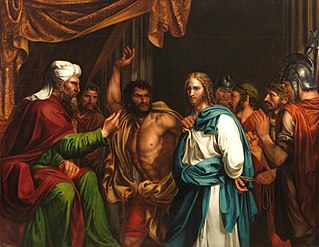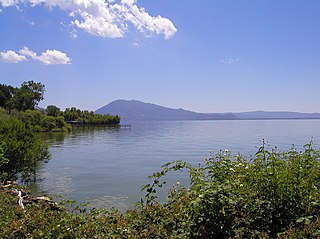
The Sanhedrin were assemblies of either twenty-three or seventy-one rabbis appointed to sit as a tribunal in every city in the ancient Land of Israel.
Semikhah or Smicha or Smicha, also smichut, smicha lerabbanut, or smicha lehazzanut, is derived from a Hebrew word which means to "rely on" or "to be authorized".

The Mendocino National Forest is located in the Coastal Mountain Range in northwestern California and comprises 913,306 acres (3,696 km2). It is the only national forest in the state of California without a major paved road entering it. There are a variety of recreational opportunities — camping, hiking, mountain biking, paragliding, backpacking, boating, fishing, hunting, nature study, photography, and off-highway vehicle travel.
Nezikin or Seder Nezikin is the fourth Order of the Mishna. It deals largely with Jewish criminal and civil law and the Jewish court system.
Gamaliel the Elder, or Rabban Gamaliel I, was a leading authority in the Sanhedrin in the early first century CE. He was the son of Simeon ben Hillel and grandson of the great Jewish teacher Hillel the Elder. Gamaliel is thought to have died in 52 CE. He fathered Simeon ben Gamliel, who was named for his father, and a daughter, who married a priest named Simon ben Nathanael.
A beth din is a rabbinical court of Judaism. In ancient times, it was the building block of the legal system in the Biblical Land of Israel. Today, it is invested with legal powers in a number of religious matters both in Israel and in Jewish communities in the Diaspora, where its judgments hold varying degrees of authority in matters specifically related to Jewish religious life.

On March 17, 1808, Napoleon I created three decrees in a failed attempt to bring equality and to integrate the Jews into French society after the Jewish Emancipation of 1790-1791. The Infamous Decree, the third of the three, had adverse effects. Although the decrees' aim was to further emancipate the Jews into equal citizenship, it restricted Jewish money lending, it annulled all debts owed to Jews by non Jewish debtors and limited the residency of new Jewish peoples in France by restricting all business activities while allowing work in agriculture and regular craftsmanship. The combination of these decrees severely weakened the financial position of once dominant rural French money lending Jews.

Hakham is a term in Judaism, meaning a wise or skillful man; it often refers to someone who is a great Torah scholar. It can also refer to any cultured and learned person: "He who says a wise thing is called a hakham, even if he be not a Jew." Hence in Talmudic-Midrashic literature, wise gentiles are commonly called hakme ummot ha-'olam.
The Hall of Hewn Stones was the meeting place of the Sanhedrin during the Second Temple period. The Talmud deduces that it was built into the north wall of the Temple, half inside the sanctuary and half outside, with doors providing access both to the temple and to the outside. The name presumably arises to distinguish it from the buildings in the temple complex used for ritual purposes, which had to be constructed of unhewn stones.
Sanhedrin (סנהדרין) is one of ten tractates of Seder Nezikin. It originally formed one tractate with Makkot, which also deals with criminal law. The Gemara of the tractate is noteworthy as precursors to the development of common law principles, for example the presumption of innocence and the rule that a criminal conviction requires the concurrence of twelve.
Gamaliel IV was and father of Judah III.
A synedrion or synhedrion is an assembly that holds formal sessions. The Latinized form is synedrium.

In the New Testament, the Sanhedrin trial of Jesus refers to the trial of Jesus before the Sanhedrin following his arrest in Jerusalem and prior to his dispensation by Pontius Pilate. It is an event reported by all four canonical gospels of the New Testament, although John's Gospel does not explicitly mention a Sanhedrin trial in this context.
Jose ben Halafta or Yose ben Halafta IPA: /ʁa'bi 'josi ben xa'lafta/) was a Tanna of the fourth generation. Jose was a student of Rabbi Akiva and was regarded as one of the foremost scholars of halakha and aggadah of his day. He was a teacher and mentor to, among other notables, Judah ha-Nasi and thus is prominently mentioned in the Mishnah, being the fifth most frequently mentioned sage in the Mishnah. Of the many Rabbi Yose's in the Talmud, Yose Ben Halafta is the one who is simply referred to as Rabbi Yose.
Modern attempts to revive the Sanhedrin are the efforts from 1538 AD until the present day to renew the Sanhedrin which was dissolved in 358 AD by the edict of the Byzantine emperor. [Though 358 was the last formal meeting, there is no record of when it was actually dissolved and by whom, nor any reference to the last nasi's execution.] The latest effort was in 2004 when a group of seventy one rabbis claiming to represent varied communities in Israel undertook a ceremony in Tiberias, where the original Sanhedrin was disbanded. That group claimed to re-establish the body, based on the proposal of Maimonides and the Jewish legal rulings of Rabbi Yosef Karo. As of March 2010, that effort is ongoing.
The 2004 attempt to re-establish the Sanhedrin was an attempt to set up a revived national rabbinical court of Jewish law in Israel which began in October 2004. The attempt has been met with the most acceptance and the least opposition among Gedolim and Rosh Yeshivas of all previous attempts in history since the disbandment of the original Sanhedrin in the 4th century. The organization heading this attempt refers to itself as the nascent Sanhedrin or developing Sanhedrin, and regards itself as a provisional body awaiting integration into the Israeli government as both a supreme court and an upper house of the Knesset, while the Israeli secular press regards it as an illegitimate fundamentalist organization of rabbis. The organization, which is composed of over 70 rabbis, claims to enjoy recognition and support from the entire religious Jewish community in Israel, and has stirred debate in both religious and secularist circles.

Sanhedria is a Haredi neighborhood in northern Jerusalem. It lies east of Golda Meir Street and adjacent to Ramat Eshkol, Shmuel HaNavi, Maalot Dafna and the Sanhedria Cemetery.
The Sanhedrin was an assembly of judges.

Tombs of the Sanhedrin, also called Tombs of the Judges, is an underground complex of 63 rock-cut tombs located in a public park in the northern Jerusalem neighborhood of Sanhedria. Constructed in the 1st century A.D., the tombs are noted for their elaborate design and symmetry. They have been a site for Jewish pilgrimage since the medieval period.










